Lisbon, Portugal’s vibrant capital, is a city full of history, culture, and breathtaking views. Whether you’re an art lover, a foodie, or someone who enjoys exploring ancient neighborhoods, Lisbon has something for everyone. From picturesque tram rides through historic streets to relaxing moments on the beach, here’s a list of the best things to do in Lisbon, each offering a unique experience. Let’s dive into the highlights that will make your trip unforgettable!

Ride Tram 28 through Historic Streets
Address: Tv. Oliveira à Estrela 19
| Type | Sightseeing |
| Time to Spend | Less than 1 hour |
History and Significance: Tram 28 has been a symbol of Lisbon for decades, first introduced in 1914. The tram is an essential part of the city’s transport history, providing both locals and tourists with a charming ride through Lisbon’s iconic districts.
What to Expect: You can expect a nostalgic journey through cobbled streets, passing landmarks such as St. George’s Castle and the Alfama neighborhood. The tram ride is a unique way to explore Lisbon’s old-world charm.
Visitor Information: Tram 28 departs frequently from various locations around the city, including Martim Moniz. Tickets can be purchased on board or from metro stations, and the ride is included in public transportation passes.
One of the most iconic experiences in Lisbon is riding Tram 28, which travels through the heart of the city’s historic districts. This traditional yellow tram passes through charming neighborhoods such as Alfama, Baixa, and Graça, offering a scenic route with stunning views of the city’s architecture. Along the way, you’ll get to admire landmarks like the majestic St. George’s Castle and the narrow cobbled streets of Alfama, providing an authentic, picturesque glimpse of Lisbon’s rich history.

Visit Belém District’s Iconic Monuments
Address: Belém
| Type | Free, Neighborhood/Area, Sightseeing |
| Time to Spend | Half Day to Full Day |
History and Significance: The Belém district is home to several of Lisbon’s most significant historical sites, including the Jerónimos Monastery and Belém Tower, which date back to the Age of Discovery. These monuments celebrate Portugal’s maritime history.
What to Expect: Visitors can explore the grandeur of the Jerónimos Monastery, the fortress-like Belém Tower, and the Monument to the Discoveries. The district also offers stunning riverside views.
Visitor Information: Belém is easily accessible by tram, bus, or taxi. It is free to visit many of the monuments, but entry fees may apply to some attractions.
Belém is a historic district in Lisbon that boasts some of the city’s most famous landmarks, including the Jerónimos Monastery, a UNESCO World Heritage site, and the Belém Tower, which stands proudly on the Tagus River. The district is also home to the Monument to the Discoveries, celebrating Portugal’s Age of Exploration. A visit to Belém wouldn’t be complete without tasting the world-famous Pastéis de Belém, a traditional Portuguese custard tart, available at the iconic bakery of the same name.
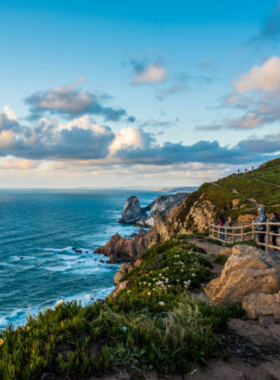
Enjoy the Views at Cabo da Roca
Address: Estrada do Cabo da Roca s/n
| Type | Free, Hiking, Tours, Sightseeing |
| Time to Spend | Half Day to Full Day |
History and Significance: Cabo da Roca is the westernmost point of mainland Europe, a dramatic site often referenced in literature and poetry. It has historically symbolized the edge of the known world for Portuguese explorers.
What to Expect: You’ll experience breathtaking views of the Atlantic Ocean from the cliffs. A lighthouse marks the spot, and there are scenic trails to explore around the area.
Visitor Information: Cabo da Roca is accessible by car or guided tours. It is open year-round, and it’s advisable to bring warm clothing due to the coastal wind.
Cabo da Roca, located on the westernmost point of Europe, offers some of the most breathtaking views in Lisbon. From its dramatic cliffs, you can gaze out at the vast Atlantic Ocean, making it a must-visit spot for nature lovers and photographers. The lighthouse at Cabo da Roca marks a historical point, and visitors can explore nearby hiking trails to discover secluded beaches like Praia da Ursa. This stunning landscape provides a peaceful escape from the city’s hustle and bustle.
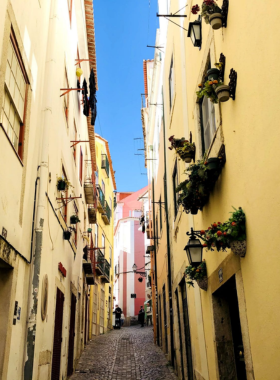
Wander Through Alfama’s Narrow Streets
Address: Alfama
| Type | Free, Neighborhood/Area, Sightseeing |
| Time to Spend | 2 hours to Half Day |
History and Significance: Alfama is one of Lisbon’s oldest neighborhoods, dating back to Roman times. It survived the 1755 earthquake, maintaining its original medieval charm.
What to Expect: You’ll wander through winding alleys, discover local shops and cafés, and experience traditional Fado music in intimate venues. It’s a place where the past truly comes to life.
Visitor Information: Alfama is best explored on foot. Comfortable shoes are recommended, as the area’s cobbled streets can be uneven. It is a free area to visit.
Alfama, one of Lisbon’s oldest neighborhoods, is a maze of narrow, winding streets that seem to take you back in time. This charming district is filled with traditional houses, small shops, and cozy cafés, each corner offering a new photo opportunity. As you wander, you’ll hear the haunting sounds of Fado, a traditional Portuguese music genre. Don’t miss the Miradouro de Santa Luzia for sweeping views of the city and the Tagus River, making it an ideal spot for a peaceful break.
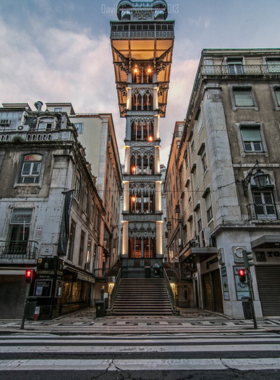
Ascend the Santa Justa Lift for Spectacular Views
Address: R. do Ouro
| Type | Sightseeing |
| Time to Spend | Less than 1 hour |
History and Significance: Built in 1902, the Santa Justa Lift is a historic vertical lift that connects the lower Baixa district with the elevated Carmo Square. It’s an iconic example of Lisbon’s industrial architecture.
What to Expect: At the top, you’ll be rewarded with sweeping views of Lisbon’s cityscape, including St. George’s Castle and the Tagus River.
Visitor Information: The lift is located in the Baixa district. Tickets can be bought on-site, and the lift operates daily, offering easy access to the city’s higher elevations.
The Santa Justa Lift is an iconic part of Lisbon’s skyline, offering a quick and scenic way to travel between the Baixa and Bairro Alto districts. Built in the early 20th century, this wrought-iron lift gives you an excellent vantage point of the city. Once at the top, you’ll be treated to panoramic views of Lisbon, including St. George’s Castle, the Alfama district, and the beautiful Baixa area. It’s a perfect spot for a photo and to take in the breathtaking sights.
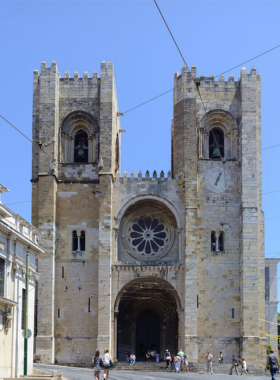
Explore the Majestic Lisbon Cathedral
Address: Largo da Sé
| Type | Free, Churches/Religious Sites, Sightseeing |
| Time to Spend | Less than 1 hour |
History and Significance: The Lisbon Cathedral, or Sé de Lisboa, was constructed in 1150 and is one of the oldest buildings in the city. It has witnessed significant events in Portugal’s history.
What to Expect: Inside, you’ll find Romanesque and Gothic architecture, with impressive relics, tombs, and artwork. The cathedral offers a serene atmosphere for reflection and exploration.
Visitor Information: The Lisbon Cathedral is free to visit, though donations are appreciated. It is open to the public every day except for religious ceremonies.
The Lisbon Cathedral (Sé de Lisboa) is a stunning historical landmark that offers a glimpse into the city’s past. Built in the 12th century, the cathedral blends Romanesque, Gothic, and Baroque architectural styles, with impressive wooden doors and towering bell towers. Inside, you’ll find intricate carvings and stunning stained-glass windows. The cathedral’s cloisters and treasury are also worth exploring. Located in the heart of the city, the Lisbon Cathedral provides an ideal starting point for exploring the Alfama district.
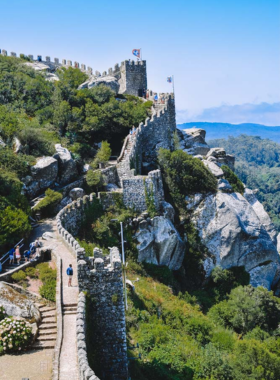
Discover the Palaces of Sintra
Address: Calçada do Pelourinho
| Type | Free, Neighborhood/Area, Sightseeing |
| Time to Spend | Half Day to Full Day |
History and Significance: Sintra is a UNESCO World Heritage site renowned for its fairy-tale castles and palaces, such as Pena Palace and the Moorish Castle, built by Portuguese royalty.
What to Expect: Expect breathtaking palaces set against lush forests, with colorful facades, ornate interiors, and spectacular views. The region is a blend of history, architecture, and nature.
Visitor Information: Sintra is easily accessible by train from Lisbon, taking about 40 minutes. The palaces have entrance fees, and a multi-site pass is available for those wishing to visit several landmarks.
A short day trip from Lisbon, Sintra is a fairytale town nestled in the lush hills of the Sintra Mountains. Famous for its enchanting palaces, such as the colorful Pena Palace, Sintra offers a magical escape from the city. The Pena Palace, perched atop a hill, is a vibrant mix of architectural styles and offers panoramic views of the surrounding countryside. Other highlights include the Moorish Castle and the National Palace of Sintra, each contributing to the town’s rich cultural heritage.

Admire Azulejos at the National Tile Museum
Address: R. Me. Deus 4
| Type | Museum |
| Time to Spend | 1 to 2 hours |
History and Significance: The National Tile Museum showcases the history of the azulejo, a traditional Portuguese ceramic tile that has been part of the nation’s culture since the 15th century.
What to Expect: Visitors can explore a wide range of azulejos, from early Islamic designs to modern pieces. The museum is housed in a beautiful convent, adding to the historical experience.
Visitor Information: The museum is located in the Xabregas district. It is open daily, with discounted entry for students and seniors. Audio guides are available to enhance the experience.
Portugal is renowned for its traditional azulejos—decorative ceramic tiles—and the National Tile Museum (Museu Nacional do Azulejo) is the best place to explore this unique art form. Housed in a former convent, the museum displays an impressive collection of tiles, showcasing their evolution from the 15th century to modern designs. Visitors can learn about the history and significance of azulejos in Portuguese culture, and the museum’s exhibits provide a fascinating look at how these tiles have adorned everything from churches to palaces.
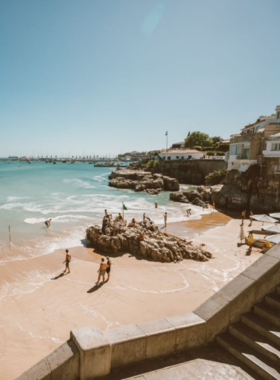
Relax at Cascais Beach
Address: Cascais/Guincho
| Type | Beaches, Free, Neighborhood/Area, Sightseeing |
| Time to Spend | More than Full Day |
History and Significance: Cascais was once a fishing village but became a royal retreat in the 19th century, known for its beautiful beaches and elegant architecture.
What to Expect: Cascais offers a mix of lively beach activities, quiet coves, and a vibrant town atmosphere. Enjoy swimming, sunbathing, or exploring the charming local shops and restaurants.
Visitor Information: Cascais is a 40-minute train ride from Lisbon. The beaches are free to access, and there are plenty of beachfront cafés and restaurants for a relaxing meal.
Cascais, a charming coastal town just outside of Lisbon, is home to beautiful sandy beaches that attract both locals and tourists. The town has a relaxed, laid-back atmosphere, making it the perfect destination for a beach day. Cascais Beach offers calm waters ideal for swimming and sunbathing, while the picturesque marina is perfect for a leisurely walk. For a more private experience, head to Praia da Rainha, a secluded beach nestled between cliffs. Cascais is also famous for its vibrant nightlife and waterfront dining options.
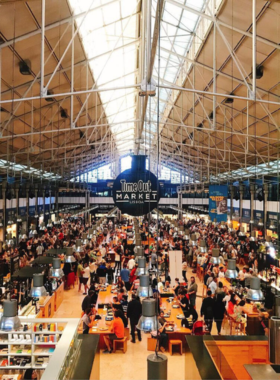
Taste Lisbon’s Best Food at Mercado da Ribeira
Address: Mercado da Ribeira, Av. 24 de Julho,
| Type | Neighborhood area, Sightseeing |
| Time to Spend | 2 hours to Half Day |
History and Significance: Mercado da Ribeira dates back to 1882 and has been a staple of Lisbon’s culinary culture, offering fresh produce, seafood, and local delicacies.
What to Expect: Expect a variety of food stalls serving traditional Portuguese dishes, fresh seafood, and international cuisines. The market is lively and filled with locals and tourists alike.
Visitor Information: The market is located in Cais do Sodré and is open daily. It is easily accessible by metro, tram, or ferry. You can buy food directly from the vendors or enjoy it in the dining area.
Mercado da Ribeira, also known as Time Out Market, is a food lover’s paradise. Located in the Cais do Sodré neighborhood, this bustling market offers a variety of food stalls serving the best of Portuguese cuisine. From fresh seafood to traditional dishes like bacalhau (salt cod) and grilled sardines, you can sample a range of local flavors. The market also features international cuisine, artisanal products, and a selection of bars and cafés. It’s a great place to explore Lisbon’s culinary scene in one vibrant space.

Take a Day Trip to the Algarve Region
Address: Av. Dom João II Nº35 11ºA, 1990-083 Lisboa, Portugal
| Type | Tours |
| Time to Spend | Half Day to Full Day |
History and Significance: The Algarve region has a rich history, with its Moorish influence still visible in its architecture. It’s famous for its stunning coastline, historic towns, and fishing villages.
What to Expect: Visitors will enjoy pristine beaches, picturesque towns like Lagos, and historic sites such as the Tavira Castle. The region is perfect for nature lovers and those seeking relaxation.
Visitor Information: The Algarve is easily reachable by train or bus from Lisbon. A rental car is recommended to explore the more remote beaches and towns.
If you have time to explore beyond Lisbon, the Algarve region, located to the south, offers stunning beaches, charming towns, and dramatic coastal landscapes. Known for its golden sands and crystal-clear waters, the Algarve is perfect for a relaxing day trip. You can visit the popular beaches of Lagos, Albufeira, and Praia da Marinha, or explore the historic town of Tavira. With its Mediterranean climate, the Algarve is an ideal destination for enjoying outdoor activities like hiking, golfing, and water sports.

Experience the Fado Music at a Traditional Club
Address: Lisbon, portugal
| Type | Neighborhood area, Sightseeing |
| Time to Spend | 1 to 2 hours |
History and Significance: Fado music has been a part of Lisbon’s culture for centuries. Recognized by UNESCO as Intangible Cultural Heritage, it reflects Portugal’s melancholic soul.
What to Expect: In intimate clubs, you’ll experience soulful performances of Fado, sung in Portuguese and accompanied by traditional instruments. The music often expresses themes of longing, love, and loss.
Visitor Information: Fado performances are held nightly in districts like Alfama and Bairro Alto. Reservations are recommended, especially for the more popular venues.
Fado is an integral part of Lisbon’s cultural identity, and there’s no better place to experience it than in one of the city’s traditional Fado clubs. This soulful music genre, characterized by its melancholic and emotional sound, is often accompanied by a singer, a Portuguese guitar, and a classical guitar. You can enjoy Fado performances in the Alfama and Bairro Alto districts, where intimate venues offer a unique and memorable experience. For a truly authentic atmosphere, opt for a small, local club where you can immerse yourself in the music.
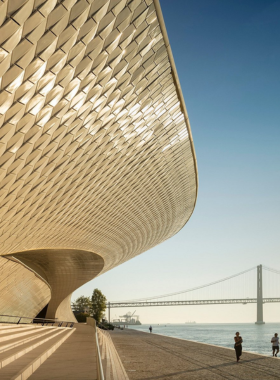
Explore the Modern Art at MAAT
Address: Av. Brasília, 1300-598 Lisboa, Portugal
| Type | Museum |
| Time to Spend | 2 hours to Half Day |
History and Significance: MAAT, the Museum of Art, Architecture, and Technology, opened in 2016 and quickly became one of Lisbon’s most dynamic cultural spaces, merging modern art with innovative architecture.
What to Expect: Expect engaging exhibitions, interactive installations, and stunning views from the museum’s rooftop. MAAT’s design is futuristic, and the museum hosts contemporary art from around the world.
Visitor Information: The museum is located in the Belém district and is open Tuesday through Sunday. Tickets can be purchased online or on-site, with discounts available for students.
The Museum of Art, Architecture, and Technology (MAAT) is one of Lisbon’s most impressive modern attractions. Located along the riverfront, MAAT combines contemporary art with innovative architecture, creating a space that is as visually stunning as the exhibitions it hosts. The museum’s design features sleek, flowing lines and an open-air terrace with panoramic views of the Tagus River. Inside, you can explore a variety of art exhibits, installations, and architecture displays that challenge traditional concepts of art and design, making it a must-see for art enthusiasts.
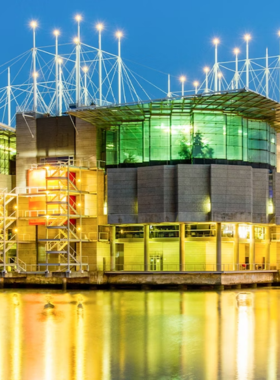
Visit the Lisbon Oceanarium
Address: Esplanada Dom Carlos I s/nº
| Type | Zoos and Aquariums, Sightseeing |
| Time to Spend | 2 hours to Half Day |
History and Significance: The Lisbon Oceanarium, opened in 1998, is one of the largest indoor aquariums in the world, dedicated to ocean conservation and education.
What to Expect: The Oceanarium features a massive central tank filled with marine life, including sharks, rays, and sea turtles. Interactive exhibits educate visitors about ocean ecosystems and sustainability efforts.
Visitor Information: The Oceanarium is located in Parque das Nações and is open every day. Tickets can be purchased online or at the entrance, and guided tours are available.
The Lisbon Oceanarium is one of the largest indoor aquariums in Europe and a great place for visitors of all ages. Located in the Parque das Nações district, the oceanarium showcases a wide variety of marine species from all over the world, including sharks, rays, and penguins. The centerpiece is the massive central tank, which houses a diverse range of sea creatures. Educational exhibits highlight marine conservation efforts, making it an entertaining and informative visit for anyone interested in ocean life and sustainability.
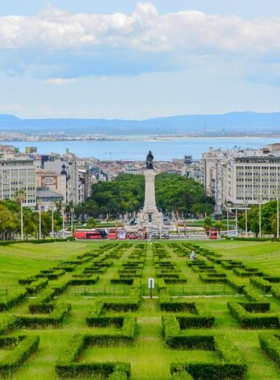
Stroll Through Eduardo VII Park
Address: 1070-051 Lisbon, Portugal
| Type | Parks & Gardens |
| Time to Spend | 1 to 2 hours |
History and Significance: Named after King Edward VII of England, Eduardo VII Park offers a peaceful retreat in the heart of Lisbon. It is one of the largest green spaces in the city, established in the early 20th century.
What to Expect: Expect beautifully landscaped gardens, wide-open spaces, and panoramic views of the city. The park also features the Estufa Fria, a large greenhouse showcasing tropical and subtropical plants.
Visitor Information: Eduardo VII Park is open to the public every day and is free to enter. It is easily accessible from the city center by foot or public transport.
Eduardo VII Park, located in the center of Lisbon, is a peaceful oasis offering a perfect escape from the city’s hustle and bustle. The park features beautifully landscaped gardens, walking paths, and a large pond, making it ideal for a relaxing stroll. From the park’s highest point, you can enjoy stunning views of the city and the Tagus River. The park is also home to the Estufa Fria, a greenhouse that houses a variety of plants, and is a perfect spot to enjoy a quiet moment in nature.
